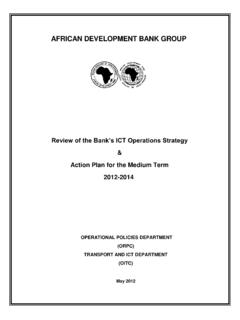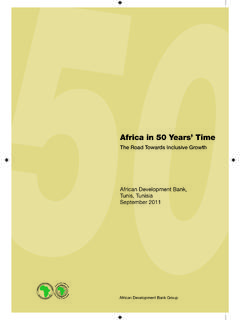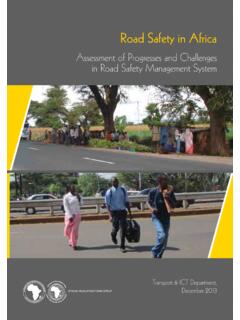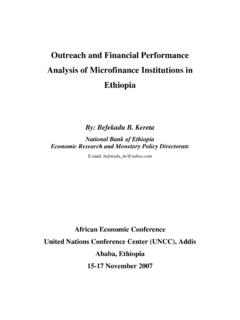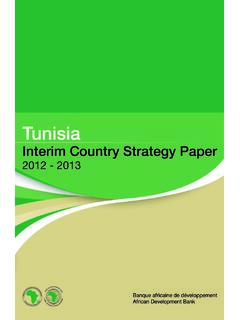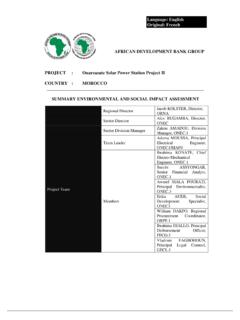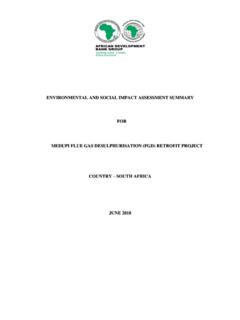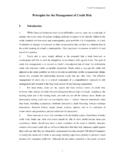Transcription of Working Paper 151 - African Development Bank
1 The Dynamics of Inflation in Ethiopia and Kenya Dick Durevall and Bo Sj No 151 - August 2012 Correct citation: Durevall, Dick and Sj , Bo (2012), The Dynamics of Inflation in Ethiopia and Kenya, Working Paper Series N 151 African Development bank , Tunis, Tunisia. Steve Kayizzi-Mugerwa (Chair) Anyanwu, John C. Faye, Issa Ngaruko, Floribert Shimeles, Abebe Salami, Adeleke Verdier-Chouchane, Audrey Coordinator Working Papers are available online at Copyright 2012 African Development bank Angle de l avenue du Ghana et des rues Pierre de Coubertin et H di Nouira BP 323 -1002 TUNIS Belv d re (Tunisia) Tel: +216 71 333 511 Fax: +216 71 351 933 E-mail: Salami, Adeleke Editorial Committee Rights and Permissions All rights reserved.
2 The text and data in this publication may be reproduced as long as the source is cited. Reproduction for commercial purposes is forbidden. The Working Paper Series (WPS) is produced by the Development Research Department of the African Development bank . The WPS disseminates the findings of work in progress, preliminary research results, and Development experience and lessons, to encourage the exchange of ideas and innovative thinking among researchers, Development practitioners, policy makers, and donors. The findings, interpretations, and conclusions expressed in the bank s WPS are entirely those of the author(s) and do not necessarily represent the view of the African Development bank , its Board of Directors, or the countries they represent.
3 The Dynamics of Inflation in Ethiopia and Kenya Dick Durevall1 and Bo Sj 2 1 Dick Durevall Department of Economics, School of Business, Economics and Law, and Centre for University of Gothenburg, Box 640, SE 405 30, Gothenburg, Sweden, email: 2 Bo Sj Department of Management and Engineering, Link ping University, SE 581 83, Link ping, Sweden, email: African Development bank GROUP Office of the Chief Economist Working Paper No. 151 August 2012 Abstract This study provides an assessment of the main drivers of inflation in Ethiopia and Kenya by developing single-equation error correction models for the Consumer Price Index in each country.
4 This approach takes into account a number of potential sources of the recent surge in inflation, including excess money supply, exchange rates, food and non-food world prices, world energy prices and domestic agricultural supply shocks. We find that the inflation rates in both Ethiopia and Kenya are driven by similar factors; world food prices and exchange rates have a long run impact, while money growth and agricultural supply shocks have short-to-medium run effects. There is also evidence of substantial inflation inertia in both countries.
5 The key conclusion is that there is no nominal anchor for inflation in either country in the form of a clear and well-functioning monetary or exchange rate policy. 5 1. Introduction Ethiopia and Kenya have experienced strong economic growth for over nearly a decade. However, inflation, which was thought to be under control, has become a major challenge. High, and volatile, inflation is a threat to good economic performance and has negative effects on many of the poor. Table 1summarizes the recent performance. Economic growth took off in 2004 in both Ethiopia and Kenya, but alongside higher growth there has been rapid inflation and large inflation volatility.
6 For example, during 2011 inflation peaked at over 40 per cent in Ethiopia and 20 per cent in Kenya. The rise of inflation in Ethiopia and Kenya is not an isolated event; other African countries are facing the same problem (AfDB, 2011). Yet, there is no consensus on the causes of the rise in inflation. A common view is that expansionary monetary policy, primarily due to large government expenditures, is the main cause, possibly in combination with negative domestic food supply shocks (AfDB, 2011; IMF, 2008; 2012a). Another view is that world food price increases raised domestic food prices (Abbott, and de Battisti, 2011; Durevall et al.)
7 , 2010). Rising food prices have then led to devaluations and feedback effects on consumer prices in general. It is widely accepted that high inflation is a monetary phenomenon related to excess money supply. The main driving forces are that government prints money to finance its deficit, it expands money supply to stimulate aggregate demand, or expectations of higher inflation force the authorities to accommodate historical price increases. However, in many Sub-Saharan countries it is challenging for monetary authorities to control inflation even if there is a political will, due to weak institutional frameworks, thin financial markets and imperfect competition among banks.
8 In such an environment, central banks might lack effective tools to control money supply (Mishra, et al., 2010). Exogenous shocks, such as poor harvests or energy-price hikes, might set off expectations and create persistent inflation due to a missing monetary anchor that ties prices down. Inflation is also related to the choice of foreign exchange regime. In principle, floating rates make it possible for the authorities to choose an inflation target independently of the rest of the world as well as to isolate or dampen foreign price shocks. A fixed exchange rate, on the other 6 hand, can only work if domestic monetary policy is consistent with inflation rates in the country s trading partners.
9 A fixed regime will also make the country more exposed to foreign price shocks. Both Ethiopia and Kenya are classified as having managed peg regimes (Slovov, 2011). The difference between the two countries is that Ethiopia ran a tight peg (towards the US dollar) for a large part of the study period; the nominal exchange rate was very stable from 2000 to 2007, but during recent years there have been several devaluations. Kenya, on the other hand, has a much more flexible regime which comes close to a floating exchange rate. Thus, the exchange rate is hardly the nominal anchor in any of the countries.
10 Policy responses in Ethiopia and Kenya during recent years illustrate well the challenges facing monetary authorities. Inflation began to rise already in 2005 in Ethiopia. Initially there was little effective response but in 2009 bank -by- bank credit ceilings were therefore introduced to control money supply growth (IMF, 2011). Inflation declined subsequently, and monetary policy was eased as evident from rapid growth in high powered and broad money. Moreover, the birr (EBT) was devalued by 16% against the US dollar in September 2010 to boost competitiveness. Later in 2010 inflation started to rise again, and in 2011 the Ethiopian authorities sharpened the focus on monetary targeting, adopting high powered money as nominal anchor (IMF, 2012c).

